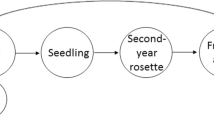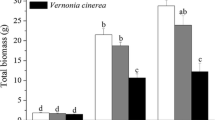Abstract
Invasive plants have become an increasingly pressing ecological problem, and the ability of invasive plants to out-compete native plants seriously threatens both biodiversity and ecosystem functionality. One invasive plant species increasing in abundance in temperate regions of the United States is Vincetoxicum rossicum (pale swallowwort), which has been observed to displace native confamilial Asclepias syriaca (common milkweed) in habitats where both species overlap. We sought to examine the effects of trait characteristics, trait variation, and density-dependent interactions on the competition between these species. We examined field-grown trait variability across an environmental gradient in western New York and applied a density-based competitive factorial design in a greenhouse setting. Both species grew in a wide range of environmental conditions in the field, but pale swallowwort exhibited more trait variation and greater specific leaf area than common milkweed, potentially reflective of increased efficiency in resource capture. Swallowwort density was a significant predictor of plant traits in the field. In the greenhouse, interspecific competition was more intense than intraspecific competition, with negative impacts of milkweed density on swallowwort growth. Although its trait variability allows it to survive in many environments, on an individual basis at low densities, swallowwort is not a strong competitor. However, this invader gains competitive advantages over native species due to Allee effects, which increase its ecological impact and success as density increases. Swallowwort is likely to remain a successful invader in disturbed temperate ecosystems and continue to have negative impacts on communities where it achieves high densities.


Similar content being viewed by others
Availability of data and materials
Upon request.
References
Bachmann D, Both S, Bruelheide H, Ding B, Gao M, Härdtle W, Scherer-Lorenzen M, Erfmeiera A (2012) Functional trait similarity of native and invasive herb species in subtropical China—environment-specific differences are the key. Environ Exp Bot 83:82–92
Baruch Z, Goldstein G (1999) Leaf construction cost, nutrient concentration, and net CO2 assimilation of native and invasive species in Hawaii. Oecol 121:183–192
Bhowmik PC (1994) Biology and control of common milkweed (Asclepias syriaca). Weed Sci Soc Am 6:227–250
Bradley BA, Laginhas BB, Whitlock R, Allen JM, Bates AE, Bernatchez G, Diez JM, Early R, Lenoir J, Vilà M, Sorte CJB (2019) Disentangling the abundance—impact relationship for invasive species. Proc Natl Acad Sci USA 116(20):9919–9924
Cappuccino N (2004) Allee effect in an invasive alien plant, pale swallow-wort Vincetoxicum rossicum (Asclepiadaceae). Oikos 106:3–8
Cappuccino N, Mackay R, Eisner C (2002) Spread of the invasive alien vine Vincetoxicum rossicum: tradeoffs between seed dispersability and seed quality. Am Midl Nat 148(2):263–270
Casagrande RA, Dacey JE (2007) Monarch butterfly oviposition on swallow-worts (Vincetoxicum spp.). Environ Entomol 36(3):631–636
Chapin FS III, Sala OE, Burke IC, Grime JP, Hooper DU, Lauenroth WK, Lombard A, Mooney HA, Mosier AR, Naeem S, Pacala SW, Roy J, Steffen WL, Tilm D (1998) Ecosystem consequences of changing. Biodiversity Biosci 48(1):45–52
Cornelissen JHC, Lavorel S, Gavnier E, Diaz S, Buchmann N, Gurvich DE, Reich PB, Steege H, Morgan HD, Heijden MGA, Pausas JG, Poorter H (2003) A handbook of protocols for standardized and easy measurement of plant functional traits worldwide. Aust J Bot 51:335–380
Daehler CC (2003) Performance comparisons of co-occurring native and alien invasive plants: implications for conservation and restoration. Annu Rev Ecol Evol Syst 34:183–211
Davidson AM, Jennions M, Nicotra AB (2011) Do invasive species show higher phenotypic plasticity than native species and if so, is it adaptive? A meta-analysis. Ecol Lett 14:419–431
Denis MS, Cappuccino N (2004) Reproductive biology of Vincetoxicum rossicum (Kleo.) Barb. (Asclepiadaceae), an invasive alien in Ontario. J Torrey Bot 131(1):8–15
DeToy J (2017) Investigating the allelopathic effects of pale swallowwort (Cynanchum rossicum) on the growth success of common milkweed (Asclepias syriaca) and pale swallowwort. Thesis, The College at Brockport, Brockport, NY
DiTommaso A, Losey JE (2003) Oviposition preference and larval performance of monarch butterflies (Danaus plexippus) on two invasive swallow-wort species. Entomol 108(3):205–209
DiTommaso A, Lawlor FM, Darbyshire SJ (2005) The biology of invasive alien plants in Canada. II. Cynanchum rossicum (Kleopow) Borhidi [= Vincetoxicum rossicum (Kleopow) Barbar.] and Cynanchum louiseae (L.) Kartesz & Gandhi [=Vincetoxicum nigrum (L.) Moench]. Can J Plant Sci 85:243–263
Divíšek J, Chytrý M, Beckage B, Gotelli N, Lososová Z, Pyšek P, Richardson D, Molofsky J (2018) Similarity of introduced plant species to native ones facilitates naturalization, but differences enhance invasion success. Nat Commun 9:4631
Douglass CH, Weston LA, Wolfe D (2011) Phytotoxicity and potential allelopathy in pale (Cynanchum rossicum) and black swallowwort (C. nigrum). Invasive Plant Sci Manag 4:133–141
Douglass CH, Weston LA, DiTommaso A (2009) Black and pale swallow-wort (Vincetoxicum nigrum and V. rossicum): the biology and ecology of two perennial, exotic and invasive vines. In: Inderjit (eds) Management of invasive weeds. Invading nature—Springer Series in Invasion Ecology, vol 5. Springer, Dordrecht, pp 261–277
Ebeling A, Meyer ST, Abbas M, Eisenhauer N, Hillebrand H, Lange M, Scherber C, Vogel A, Weigelt A, Weisser WW (2014) Plant diversity impacts decomposition and herbivory via changes in aboveground arthropods. PLoS ONE 9(9):e106529
Ernst CM, Cappuccino N (2005) The effect of an invasive alien vine, Vincetoxicum rossicum (Asclepiadaceae) on arthropod populations in Ontario old fields. Biol Invasions 7:417–425
Flockhart DTT, Pichancourt JB, Norris DR, Martin TG (2014) Unravelling the annual cycle in a migratory animal: breeding-season habitat loss drives population declines of monarch butterflies. J Anim Ecol 84(1):155–165
Freckleton RP, Watkinson AR (2000) Designs for greenhouse studies of interactions between plants: an analytical perspective. J Ecol 88:386–391
Gallagher RV, Randall RP, Leishman MR (2014) Trait differences between naturalized and invasive plant species independent of residence time and phylogeny. Conserv Biol 29:360–369
Gibson DJ, Connolly J, Hartnett DC, Weidenhammer JD (1999) Designs for greenhouse studies of interactions between plants. J Ecol 87(1):1–16
Goldberg DE, Werner PA (1983) Equivalence of competitors in plant communities: a null hypothesis and a field experimental approach. Am J Bot 70:1098–1104
Grotkopp E, Rejmánek M, Rost TL (2001) Toward a causal explanation of plant invasiveness: seedling growth and life-history strategies of 29 pine (Pinus) species. Am Nat 159(4):396–419
IBM Corp. Released (2013) IBM SPSS Statistics for Windows, Version 220. IBM Corp, Armonk
Inouye BD (2001) Response surface experimental designs for investigating interspecific competition. Ecology 82:2696–2706
JMP®, Version <17>. SAS Institute Inc., Cary, NC, 1989–2007.
Kardol P, Cregger MA, Campany CE, Classen AT (2010) Soil ecosystem functioning under climate change: plant species and community effects. Ecology 91(3):767–781
Levine JM, Vilà M, D’Antonio CM, Dukes JS, Grigulis K, Lavorel S (2003) Mechanisms underlying the impacts of exoctic plant invasions. Proc Biol Sci 270(1517):775–781
Malcolm SB (1994) Milkweeds, monarch butterflies and the ecological significance of cardenolides. Chemoecology 5–6:101–117
Maron JL, Auge H, Pearson DE, Korell L, Hensen I, Suding KN, Stein C (2014) Staged invasions across disparate grasslands: effects of seed provenance, consumers and disturbance on productivity and species richness. Ecol Lett 17(4):499–507
Milbrath LR, DiTommaso A, Biazzo J, Morris SH (2016) Tolerance of swallowworts (Vincetoxicum spp.) to multiple years of artificial defoliation and clipping. Invasive Plant Sci Manag 9:1–11
Minitab 17 Statistical Software (2010) Computer software. Minitab, Inc., State College. www.minitab.com
Pahlevani AH, Rashed MH, Ghorbani R (2008) Effects of environmental factors on germination and emergence of swallowwort. Weed Tech 22:303–308
Pichancourt JB, van Klinken RD (2012) Phenotypic plasticity influences the size, shape, and dynamics of the geographic distribution of an invasive plant. PLoS ONE 7(2):e32323
Pitman GM, Flockhart DTT, Norris DR (2018) Patterns and causes of oviposition in monarch butterflies: implications for milkweed restoration. Biol Conserv 217:54–65
Pyšek P, Richardson DM (2007) Traits associated with invasiveness in alien plants: Where do we stand? In: Nentwig W (ed) Biological invasions, Ecological Studies 193. Springer, Berlin, pp 97–126
Richards CL, Bossdorf O, Muth NZ, Gurevitch J, Pigliucci (2006) Jack of all trades, master of some? On the role of phenotypic plasticity in plant invasions. Ecol Lett 9(8):981–993
Sakai AK, Allendorf FW, Holt JS, Lodge DM, Molofsky J, With KA, Baughman S, Cabin RJ, Cohen JE, Ellstrand NC, McCauley DE, O’Neil P, Parker IM, Thompson JN, Weller SG (2001) The population biology of invasive species. Annu Rev Ecol Syst 32:305–332
Schneider CA, Rasband WS, Eliceiri KW (2012) NIH Image to ImageJ: 25 years of image analysis. Nat Methods 9:671–675
Schwinning S, Weiner J (1998) Mechanisms determining the degree of size asymmetry in competition among plants. Oecologia 113:447–455
Sheeley SE, Raynal DJ (1996) The distribution and status of species of Vincetoxicum in Eastern North America. Bulletin Torrey Bot Club 123:148
Sheppard CS, Carboni M, Essl F, Seebens H, Consortium D, Thuiller W (2018) It takes one to know one: similarity to resident alien species increases establishment success of new invaders. Divers Distrib 24:680–691
Snaydon RW (1991) Replacement or additive designs for competition studies? J Appl Ecol 28:930–946
Taylor CM, Hastings A (2005) Allee effects in biological invasions. Ecol Lett 8:895–908
Tewksbury L, Casagrande R, Gassmann A (2002) 16: Swallow-worts. Biol Control Invas Plants East US 4:209–216
Tordoni E, Petruzzellis F, Nardini A, Savi T, Bacaro G (2019) Make it simpler: Alien species decrease functional diversity of coastal plant communities. J Veg Sci 30(3):498–509
Valladares F, Wright SJ, Lasso E, Kitajima K, Pearcy RW (2000) Plastic phenotypic response to light of 16 congeneric shrubs from a Panamanian rainforest. Ecology 81(7):1925–1936
Valladares F, Sanchez-Gomez D, Zavala MA (2006) Quantitative estimation of phenotypic plasticity: bridging the gap between the evolutionary concept and its ecological applications. J Ecol 94(6):1103–1116
Williams DG, Mack RN, Black RA (1995) Ecophysiology of introduced Pennisetum setaceum on Hawaii: the role of phenotypic plasticity. Ecology 76:1569–1580
Zavaleta ES, Hulvey KB (2004) Realistic species losses disproportionately reduce grassland resistance to invaders. Science 306:1175–1177
Acknowledgements
The authors would like to thank K. Broz, M. Greber, C. Hartl, J. DeToy, M. Casler, C. Wolfanger, S. Ward, and K. Berend for help in the field and lab. The authors would also like to thank two anonymous reviewers whose comments improved the manuscript. This project was supported by a SUNY Brockport Foundation of Undergraduate Research Award, the Don Nelson-Nasca Fellowship for Undergraduate Research, and the Brockport Honors Thesis Support Award.
Funding
This project was supported by a SUNY Brockport Foundation of Undergraduate Research Award, the Don Nelson-Nasca Fellowship for Undergraduate Research, and the Brockport Honors Thesis Support Award.
Author information
Authors and Affiliations
Contributions
Both authors contributed to study design and data analysis. Data collection was performed by Holly Jackson. The first draft of the manuscript was written by Holly Jackson and both authors commented on previous versions of the manuscript. Both authors read and approved the final manuscript.
Corresponding author
Ethics declarations
Conflict of interest
The authors have no conflicts of interest to declare that are relevant to the content of this article.
Additional information
Communicated by Rodolfo Gentili.
Publisher's Note
Springer Nature remains neutral with regard to jurisdictional claims in published maps and institutional affiliations.
Rights and permissions
About this article
Cite this article
Jackson, H.R., Amatangelo, K.L. Density-dependent impacts of invasive Vincetoxicum rossicum (pale swallowwort) and native Asclepias syriaca (common milkweed) on plant traits and competitive interactions. Plant Ecol 222, 1065–1074 (2021). https://doi.org/10.1007/s11258-021-01161-1
Received:
Accepted:
Published:
Issue Date:
DOI: https://doi.org/10.1007/s11258-021-01161-1




